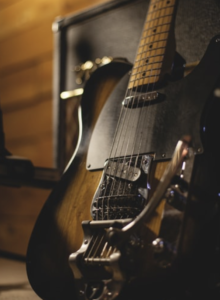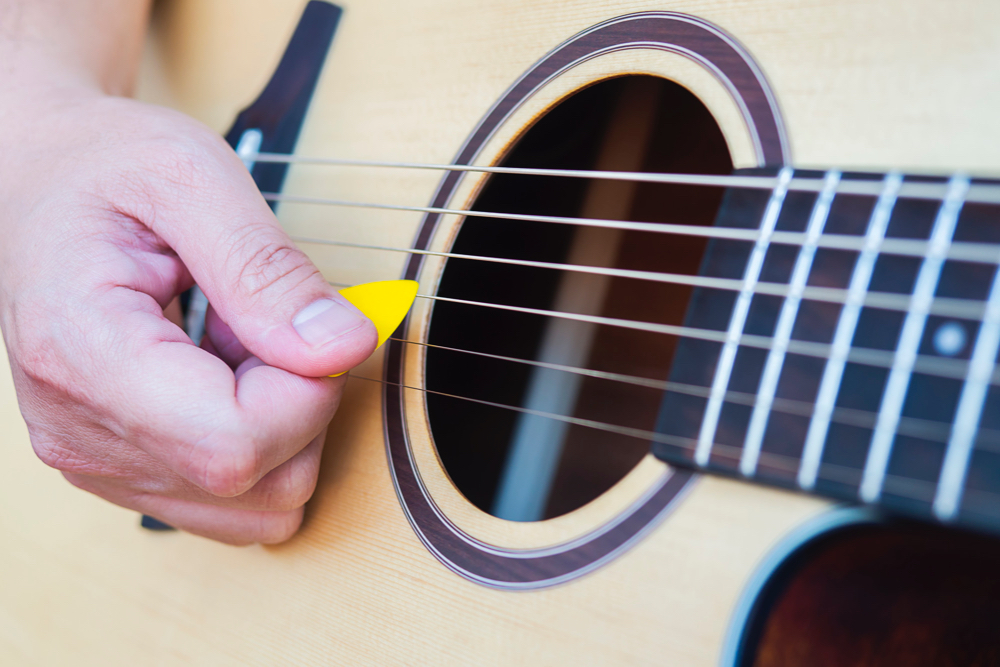Among all alternative guitar tunings, the drop-D tuning is the most popular. It offers a lot of opportunities for guitar players.
The standard tuning for the guitar is the well known E-based tuning. It follows mostly a sequence of forths between the strings, resulting in the following sequence (from higher to lower):
- First string: E
- Second string: B
- Third string: G
- Forth string: D
- Fifth string: A
- Sixth string: E

Drop-D Tuning
Notice that the only interval that is not a forth is the G-B interval, which is a third. This tuning, which is standard and used in 99% of all guitar music, is responsible for the standard scale patterns we have. This method simplifies the play of popular songs, and allows the easy use of barre chords.
Alternative Tunings
However, the standard tuning is not the only one available for guitar players. Over the years, guitarists have experimented with alternative tunings.
The idea of using an alternative tuning is to make it easier to play some particular songs. This can be done is several ways.
One idea is to make it possible to play open strings in several positions, therefore spicing the sound of a particular chord with open strings. This kind of trick can be very effective on songs that explore certain notes. The most common example of this technique is using the drop d tuning.
The Drop D Tuning
 The drop-d is a well known tuning that explores the sound of an open sting to play certain songs that use the D note.
The drop-d is a well known tuning that explores the sound of an open sting to play certain songs that use the D note.
The idea is to lower the 6th string, from E to D, and use the D to help on certain keys.
For example, the standard tuning offers a lot of opportunities to use E as part of chords. This is very good for music written in the keys of E or Em, or A and B. These are keys that use a lot the sound of E. Moreover, the Am and C keys also use E as an important note.
But with the drop D, you can benefit when playing in some other keys. The most basic example is the key of D (major or minor). In that case, you can play the tonic of D chords in the 6th string.
Similarly, the drop D also helps when playing in the key of G. The same for the key of A, where D is the 4th step.
When to Use the drop-D Tuning
The decision to use the drop-d depends on what kind of effects you want to apply. If you think a song would benefit from using a bass line that uses the D note, than it would make sense to use it.
Applying the drop-d tuning is extremely easy. The only change you need to make is to tune the 6th string to a D note, instead of the traditional E.
Songs Using Drop-D Tuning
Here are a few famous songs that use drop-d tuning:
- Dear Prudence: The Beatles
- Moby Dick: Led Zeppelin
- What I’ve Done: Linkin Park
- Heart-shaped Box: Nirvana
- Your Body Is a Wonderland: John Mayer
- Ten Years Gone: Led Zeppelin
- All Nightmare Long: Metallica
Easy Chords Using Drop-D
There are some chords that become very easy to perform using this kind of tuning. The best example is the power chord.
Remember that a power chord is one that contains only the fundamental and the fifth note, skipping the third. The normal power chord for G, for example, is the following:

However, when using the drop-D tuning, this chord becomes the following, much easier chord:

Disadvantages of the drop-D Tuning
 There are not many disadvantages, but we can notice that when using the drop-d tuning, you won’t have the traditional notes in the 6th string. This means that you need to relearn some of the chord positions.
There are not many disadvantages, but we can notice that when using the drop-d tuning, you won’t have the traditional notes in the 6th string. This means that you need to relearn some of the chord positions.
Basically, you need to practice the drop-d tuning as a separate shape set for the chords and scales using the 6th string. This may be a problem for some players. So there are some reasons for not using the drop-d tuning, if you don’t want to learn these additional chord positions.
Learn More About Tuning and Scales
If you want to learn more about guitar tuning and scales, you should get our free complete guitar course. In these guitar lessons, you’ll learn about:
- Playing any note in the fretboard
- Learning basic and advanced chords
- Tuning your guitar using different methods
- Practicing guitar scales
- Reading guitar tabs
- Knowing the parts of a guitar
- And much more
To get your free copy, just click here and request your guitar course.
